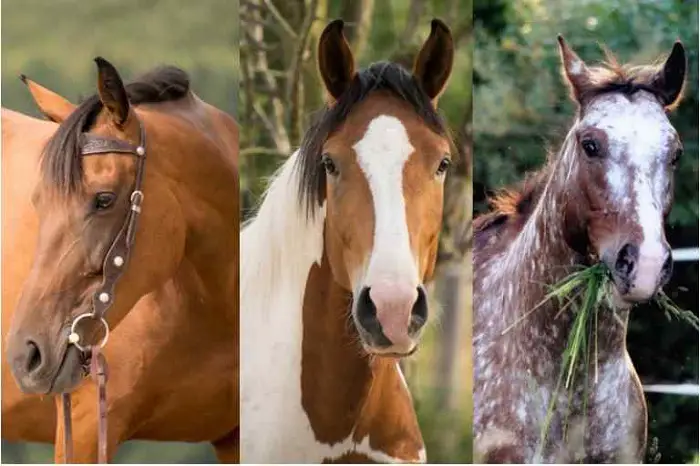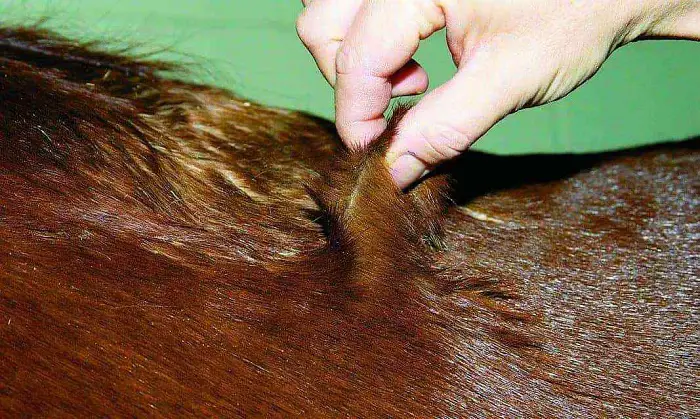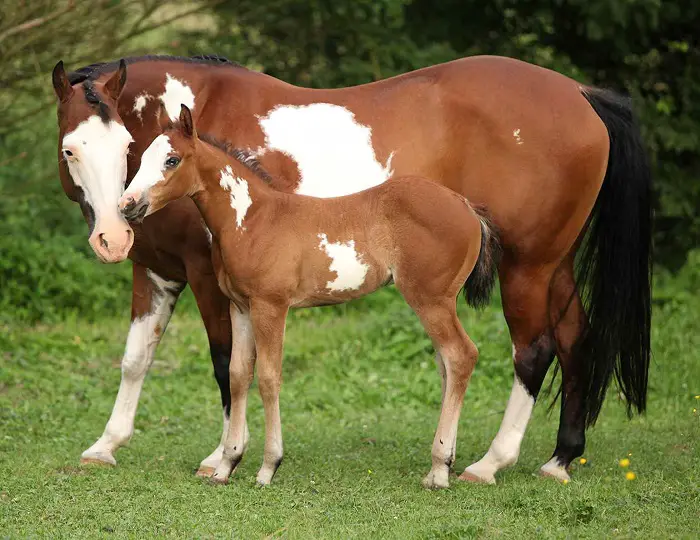HERDA in horses stands for “Hereditary Equine Regional Dermal Asthenia,” a genetic skin disorder. It is also known as “hyperelastosis cutis” or “HC.” HERDA is a hereditary condition that affects the connective tissue in the skin, leading to severe fragility and tearing of the skin, particularly in areas under saddle and harness pressure.
Horses with HERDA are born with the condition, but symptoms typically become noticeable when put under a saddle or harness. The repeated stress and pressure on the skin in these areas can lead to skin lesions, sores, and wounds that are moderate to heal. In severe cases, the skin may split open, leaving the horse vulnerable to infections and further complications.
What Causes HERDA in Horses?
Hereditary Equine Regional Dermal Asthenia is caused by a genetic mutation that affects the production and structure of collagen, a crucial protein in the body’s connective tissues. Collagen strengthens and supports various tissues, including the skin, tendons, ligaments, and other structures.
In horses with HERDA, the genetic mutation affects the PPIB gene, which is accountable for encoding a protein called cyclophilin B. Cyclophilin B plays a role in collagen synthesis and assembly. The mutation disrupts the proper function of this protein, leading to abnormal collagen fibers that are weak and prone to tearing. This makes the skin and other connective tissues fragile and less able to withstand the everyday stresses and pressures, particularly in areas under saddle and harness.
Because HERDA is an autosomal recessive gene, a horse must inherit two copies of the mutated gene to express the disorder. Horses with only one copy of the mutated gene are considered carriers and do not exhibit symptoms. Still, they can pass the mutation on to their offspring if bred to another carrier or an affected horse.
Clinical Signs of HERDA in Horses
HERDA is a genetic skin disorder primarily affecting horses. Clinical signs of HERDA typically become apparent when a horse is put under a saddle or harness, as the affected areas of the skin experience repeated stress and pressure. The severity of symptoms can vary, but common clinical signs of HERDA include:
- Skin Lesions: Affected horses are prone to developing skin lesions, sores, and wounds, especially in regions where saddle or harness pressure is applied. These areas often include the back, withers, neck, and saddle. The skin may appear thin, easily damaged, and slow to heal.
- Skin Splitting: One of the hallmark signs of HERDA is the tendency for the skin to split or tear easily. This can happen even with minimal pressure or trauma. These splits can be painful and increase the risk of infection.
- Excessive Scarring: The healing process in HERDA-affected horses can result in excessive scarring, making the skin in affected areas thicker and less pliable.
- Delayed Wound Healing: Due to the compromised nature of the skin, wounds, and lesions in HERDA-affected horses often take longer to heal. This increases the risk of secondary infections.
- Hair Loss: Hair loss, often accompanied by scaly or crusty skin, can be observed in regions with compromised skin integrity.
- Skin Separation: The layers of the skin may separate more quickly than in unaffected horses, forming “bubbles” or fluid-filled pockets beneath the skin.
- Pain and Discomfort: The skin’s fragility can cause pain and discomfort for affected horses, mainly when pressure is applied to the affected areas.
Diagnosis of HERDA in Horses
Diagnosing HERDA (Hereditary Equine Regional Dermal Asthenia) in horses involves a combination of clinical evaluation, genetic testing, and, sometimes, skin biopsies. Here’s how the diagnosis process typically works:
- Clinical Examination: A veterinarian will perform a thorough physical examination of the horse, paying close attention to any skin abnormalities, lesions, or wounds, particularly in areas prone to saddle or harness pressure. The vet will also gather information about the horse’s medical history and any family history of similar skin issues.
- Genetic Testing: Genetic testing is a crucial tool for diagnosing HERDA definitively. This involves taking a sample (usually a blood sample or hair follicle) from the horse and sending it to a specialized laboratory that offers genetic testing for HERDA. The gene laboratory will analyze the sample to determine whether the horse carries the mutated gene associated with the disorder.
- Pedigree Analysis: Understanding the horse’s pedigree is essential to assess its risk of having or carrying HERDA. Horses that have known affected ancestors or a history of producing affected offspring are at a higher risk.
- Skin Biopsy (Optional): A skin biopsy might help confirm the diagnosis in some cases. A small sample of skin tissue is taken from an affected area and examined under a microscope. This can help reveal structural abnormalities in the collagen fibers, characteristic of HERDA.
- Elimination of Other Conditions: The veterinarian may rule out other skin disorders or conditions that can cause similar symptoms, ensuring an accurate diagnosis.
Differential Diagnosis of HERDA in Horses
Horses with HERDA have fragile and easily damaged skin that forms painful lesions. Diagnosing HERDA involves considering its clinical signs and ruling out other potential conditions that might present with similar symptoms. Here are some differential diagnoses to consider:
- Equine Cutaneous Lupus Erythematosus (ECLE): This autoimmune disorder can cause skin lesions, crusting, and scarring, often affecting the face and ears. It can be challenging to distinguish from HERDA due to similar skin manifestations.
- Photosensitization: Various types of photosensitivity can cause skin issues in horses, leading to scabs, crusting, and hair loss, especially in exposed areas. Differentiating this from HERDA might require examining the horse’s history and management practices.
- Traumatic Injuries: Skin lesions caused by injuries, rubbing, or ill-fitting equipment can sometimes mimic HERDA symptoms. A thorough examination of the horse’s environment and tack may eliminate this possibility.
- Infectious Dermatopathies: Fungal or bacterial infections, such as ringworm (dermatophytosis) or bacterial folliculitis, can cause skin lesions. Culture and microscopic examination of skin samples can help differentiate infections from HERDA.
- Genetic Skin Disorders: Other hereditary skin conditions, although less common than HERDA, might resemble its clinical signs. Examples include collagen disorders like Ehlers-Danlos syndrome in humans.
- Allergic Dermatitis: Allergic reactions to various substances can lead to skin lesions, itching, and inflammation. Identifying the allergen through history and diagnostic testing can help distinguish this from HERDA.
- Immune-Mediated Disorders: Certain autoimmune conditions can affect the skin and cause lesions. These might include pemphigus foliaceus or other immune-mediated skin diseases.
- Nutritional Deficiencies: Inadequate nutrition can lead to skin problems, including hair loss and poor skin quality. A veterinarian might recommend dietary adjustments and supplementation to rule out this cause.
- Neoplastic Conditions: Sometimes, skin tumors or growths might resemble HERDA lesions. Biopsy and histopathology can be crucial in differentiating benign and malignant growths.
- Parasitic Infections: Although less likely to mimic HERDA, severe infestations with parasites like mange mites could lead to skin issues. A thorough examination and appropriate testing can rule out this possibility.
Treatment of Hereditary Equine Regional Dermal Asthenia
There is no specific treatment to cure Hereditary Equine Regional Dermal Asthenia (HERDA) in horses. HERDA is a genetic disorder caused by a mutation in the PPIB gene, and as of my last knowledge update in September 2021, there is no known cure for this condition.
Given that HERDA is a lifelong genetic condition, the management approach is focused on providing supportive care to affected horses and minimizing their discomfort. Here are some general management practices that can help improve the well-being of horses with HERDA:
- Wound Management: Since horses with HERDA have fragile skin that can easily tear and form painful lesions, proper wound management is crucial. Keep wounds clean, use non-stick dressings, and apply topical treatments as a veterinarian recommends.
- Minimize Trauma: Preventing skin trauma is essential. Use padded halters, blankets, and other equipment to minimize friction and pressure on the skin. Additionally, avoid situations where the horse might be prone to injuries.
- Fly Control: Flies and insects can exacerbate skin issues. Implement effective fly control measures to reduce irritation and the risk of further skin damage.
- Nutrition: A balanced diet with appropriate nutrients can support overall health and improve skin health. Consult a veterinarian or equine nutritionist for guidance on the proper diet for your horse.
- Pain Management: Horses with HERDA may experience discomfort or pain. Work with a veterinarian to develop a pain management plan to improve the horse’s quality of life.
- Topical Treatments: Depending on the specific needs of the horse, your veterinarian might recommend emollients, moisturizers, or other topical treatments to soothe the skin and promote healing.
- Environmental Considerations: Providing appropriate shelter and bedding is essential to protect the horse from environmental factors that could worsen its skin condition.
- Genetic Testing and Breeding Management: If you’re a breeder, performing genetic testing is crucial to identify carriers and prevent further breeding of affected horses. Responsible breeding methods can help reduce the prevalence of HERDA in future generations.
Prevention of Hereditary Equine Regional Dermal Asthenia
Preventing Hereditary Equine Regional Dermal Asthenia (HERDA) involves a combination of responsible breeding practices and genetic management. Since HERDA is a genetic disorder, it’s crucial to prevent its transmission to future generations of horses. Here are some steps to consider for preventing HERDA:
- Genetic Testing: Utilize genetic testing to identify carriers and affected horses. DNA tests are available to detect the presence of the PPIB gene mutation responsible for HERDA. Testing can help you make informed breeding decisions.
- Breeding Selection: Do not breed horses that are known carriers of the HERDA mutation. This will prevent the passing of the gene to the next generation. If a horse is affected by HERDA, it should not be used for breeding purposes.
- Pedigree Analysis: Thoroughly research the pedigrees of potential breeding pairs to identify any ancestors that were carriers or affected by HERDA. Avoid breeding combinations that elevate the risk of producing affected offspring.
- Consultation with Experts: Seek advice from veterinarians, equine geneticists, and breed organizations with HERDA and equine genetics expertise. They can guide appropriate breeding choices and strategies.
- Educate Breeders: Educate fellow breeders and horse owners about HERDA and the importance of responsible breeding practices. Encourage widespread adoption of genetic testing to reduce the prevalence of the disorder.
- Transparent Information: Be transparent about the HERDA status of your breeding horses. Providing accurate information to potential buyers can help them make informed decisions.
- Breeding Contracts: If you are selling or leasing breeding horses, consider including clauses in contracts that specify the requirement for genetic testing and restrict the breeding of carriers or affected horses.
- Continual Monitoring: Stay updated with advancements in equine genetics and research related to HERDA. As new information becomes available, adjust your breeding practices accordingly.
- Consider Alternative Goals: If a horse is found to be a carrier or affected by HERDA, consider altering breeding goals. Focus on performance, temperament, and other desirable traits not affected by the genetic mutation.
- Responsible Ownership: If you’re a horse owner, consider the possibility of genetic disorders like HERDA when purchasing a horse. Be aware of the horse’s genetic status and its implications for breeding.
Concluding Remarks on HERDA in Horses
In conclusion, Hereditary Equine Regional Dermal Asthenia (HERDA) is a challenging genetic skin disorder that primarily affects certain horse breeds, including American Quarter Horses. It is caused by a mutation in the PPIB gene, leading to the weakening and fragility of the skin, resulting in painful lesions, scars, and discomfort for the affected horses. While there is no cure for HERDA, responsible management practices are crucial to improving the quality of life for affected horses and preventing its spread to future generations.


